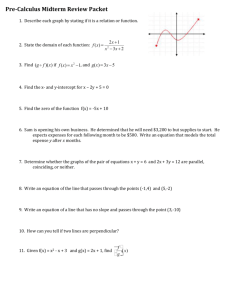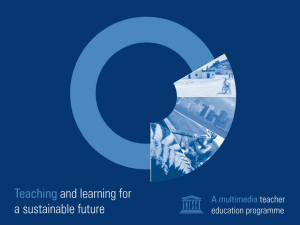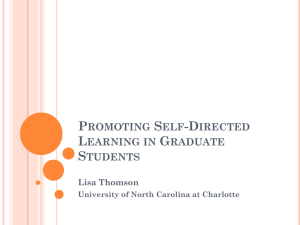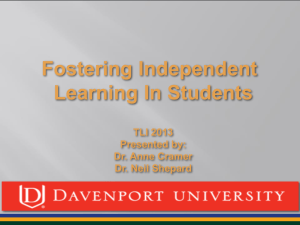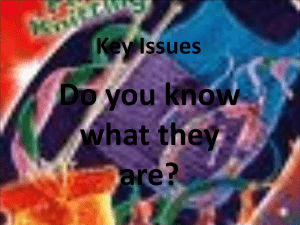Boyatzis` Theory of Self-Directed Learning - Salto
advertisement
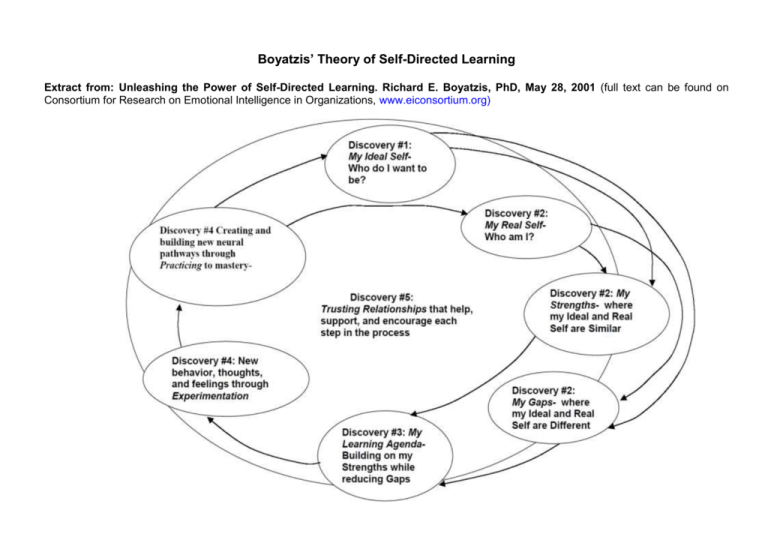
Boyatzis’ Theory of Self-Directed Learning Extract from: Unleashing the Power of Self-Directed Learning. Richard E. Boyatzis, PhD, May 28, 2001 (full text can be found on Consortium for Research on Emotional Intelligence in Organizations, www.eiconsortium.org) The First Discontinuity: Catching Your Dreams, Engaging Your Passion The first discontinuity and potential starting point for the process of self-directed learning is the discovery of who you want to be. Our Ideal Self is an image of the person we want to be. It emerges from our ego ideal, dreams, and aspirations, The last twenty years has revealed literature supporting the power of positive imaging or visioning in sports psychology, appreciative inquiry (Cooperrider, 1990), meditation and biofeedback research, and other psycho-physiological research. It is believed that the potency of focusing one’s thoughts on the desired end state of condition is driven by the emotional components of the brain (Goleman, 1995). The Ideal Self is a reflection of the person’s intrinsic drives. Numerous studies have shown that intrinsic motives have more enduring impact on a person’s behaviour than extrinsic motives (Deci and Ryan, 1985). Our aspirations, dreams, and desired states are shaped by our values, philosophy (Boyatzis, Murphy, and Wheeler, 2000), life and career stages (Boyatzis and Kolb, 1999), motives (McClelland, 1985), role models, and other factors. This research indicates that we can access and engage deep emotional commitment and psychic energy if we engage our passions and conceptually catch our dreams in our Ideal Self-image. It is an anomaly that we know the importance of consideration of the Ideal Self, and yet often, when engaged in a change or learning process we skip over the clear formulation or articulation of our Ideal Self image. If a parent, spouse, boss, or teacher, tells us something that should be different, they are giving us their version of our Ideal Self. They are telling us about the person they want us to be. The extent to which we believe or accept this image determines that extent to which it becomes part of our Ideal Self. Our reluctance to accept others’ expectations or wishes for us to change is one of many reasons why we may not live up to others’ expectations or wishes, and not change or learn according to their agenda! In current psychology, others’ version of what our Ideal Self should be is referred to as the “Ought Self.” We may be victims of the expectations of others and the seductive power of popularized images from the media, celebrities, and our reference groups. In his book, The Hungry Spirit: Beyond Capitalism, A Quest for Purpose in the Modern World (1997), Charles Handy describes the difficulty of determining his ideal. “I spent the early part of my life trying hard to be someone else. At school I wanted to be a great athlete, at university an admired socialite, afterwards a businessman and, later, the head of a great institution. It did not take me long to discover that I was not destined to be successful in any of these guises, but that did not prevent me from trying, and being perpetually disappointed with myself. The problem was that in trying to be someone else I neglected to concentrate on the person I could be. That idea was too frightening to contemplate at the time. I was happier going along with the conventions of the time, measuring success in terms of money and position, climbing ladders which others placed in my way, collecting things and contacts rather than giving expression to my own beliefs and personality. (pg. 86)” In this way, we allow ourselves to be anesthetized to our dreams and lose sight of our deeply felt Ideal Self. The Second Discontinuity: Am I a Boiling Frog? The awareness of the current self, the person that others see and with whom they interact, is elusive. For normal reasons, the human psyche protects itself from the automatic “intake” and conscious realization of all information about ourselves. These ego-defence mechanisms serve to protect us. They also conspire to delude us into an image of who we are that feeds on itself, becomes self-perpetuating, and eventually may become dysfunctional (Goleman, 1985). The "boiling frog syndrome" applies here. It is said that if one drops a frog into a pot of boiling water, it will jump out with an instinctive defence mechanism. But if you place a frog in a pot of cool water and gradually increase the temperature, the frog will sit in the water until it is boiled to death. These slow adjustments to changes are acceptable, but the same change made dramatically is not tolerated. The greatest challenge to an accurate current self-image (i.e., seeing yourself as others see you and consistent with other internal states, beliefs, emotions, and so forth) is the boiling frog syndrome. Several factors contribute to it. First, people around you may not let you see a change. They may not give you feedback or information about how they see it. Also, they may be victims of the boiling frog syndrome themselves, as they adjust their perception on a daily basis. For example, when seeing a friend’s child after two years, you may gasp as to how fast they have grown. Meanwhile, the parent is only aware of the child’s growth when they have to buy new shoes, clothes, or a sudden change in the child’s hormonal balance leading to previously unlikely behaviour. Second, enablers, those forgiving the change, frightened of it, or who do not care, may allow it to pass unnoticed. Our relationships and interpersonal context mediate and interpret cues from the environment. They help us interpret what things mean. You ask a friend, “Am I getting fat?” To which she responds, “No, you look great!” Whether this is reassuring to the listener or not, it is confusing and may not be providing feedback to the question asked. Of course, if she had said, “No, it is just the spread of age or normal effects of gravity” you may not have more useful information either. In counseling sessions with effective CEOs and Managing Directors of not-for-profits, I have often been surprised by their lack of seeing themselves as leaders. Others may see them as leaders. Sometimes humility blocks this perception. Sometimes, it is the interpersonal or cultural context. On the planet Krypton, Superman was just another citizen without “supernatural” power. This lack of admitting that which is obvious to others to yourself can also occur when you have prolonged spiritual blackouts, losing sight of your core values and your philosophy. Some organizational cultures will, as mentioned earlier, encourage a preoccupation with the “gaps.” Some individuals have philosophies, or value orientations, that push them to focus on areas of improvement (i.e., a Pragmatic Value Orientation or philosophy, Boyatzis et. al., 2000, or a dominant underlying motive of the Need for Achievement, McClelland, 1985). Some individuals have such a low level of self-confidence or self-esteem that they assume they are unworthy and distrust positive feedback and focus on negative issues and the gaps. For a person to truly consider changing a part of himself or herself, you must have a sense of what you value and want to keep. Likewise, to consider what you want to preserve about yourself involves admitting aspects of yourself that you wish to change or adapt in some manner. Awareness of these two and exploring them exist in the context of each other. All too often, people explore growth or development by focusing on the “gaps” or deficiencies. Organizational training programs and managers conducting annual “reviews” often commit the same mistake. There is an assumption that we can “leave well enough alone” and get to the areas that need work. It is no wonder that many of these programs or procedures intended to help a person develop result in the individual feeling battered, beleaguered and bruised, not helped, encouraged, motivated, or guided. The gaps may get your attention because they disrupt progress or flow (Fry, 1998). Exploration of yourself in the context of your environment (How am I fitting into this setting? How am I doing in the view of others? Am I part of this group or organization or family?) and examination of your Real Self in the context of your Ideal Self both involve comparative and evaluative judgments. A comprehensive view includes both strengths and weaknesses. That is, to contemplate change, one must contemplate stability. To identify and commit to changing parts of yourself you must identify those parts you want to keep and possibly enhance. In this way, adaptation does not imply or require “death” but evolution of the self. There are four major “learning points” from the first two discontinuities in the self-directed learning process: 1) Engage your passion and create your dreams; and 2) Know thyself! 3) Identify or articulate both your strengths (those aspects of yourself you want to preserve) and your gaps or discrepancies of your Real and Ideal Selves (those aspects of yourself you want to adapt or change); and 4) Keep your attention on both characteristics, forces or factors—do not let one become the preoccupation! All of these learning points can be achieved by finding and using multiple sources for feedback about your Ideal Self, Real Self, Strengths, and Gaps. The sources of insight into your Real Self can include systematically collecting information from others, such as 360 degree feedback currently considered fashionable in organizations. Other sources of insight into your Real Self, Strengths and Gaps may come from behavioral feedback through videotaped or audiotaped interactions, such as collected in assessment centres. Various psychological tests can help you determine or make explicit inner aspects of your Real Self, such as values, philosophy, traits, motives, and such. Sources for insight into your Ideal Self are more personal and more elusive than those for the Real Self. Various exercises and tests can help by making explicit various dreams or aspirations you have for the future. Talking with close friends or mentors can help. Allowing yourself to think about your desired future, not merely your prediction of your most likely future is the biggest obstacle. These conversations and explorations must take place in psychologically safe surroundings. Often, the implicit norms of one’s immediate social groups and work groups do not allow nor encourage such discussion. In this case, you may want to search for groups who are considering changing their lives in an academic program, career development workshop, or personal growth experience. The Third Discontinuity: Mindfulness Through a Learning Agenda The third discontinuity in self-directed learning is development of an agenda and focusing on the desired future. A learning orientation will replace a performance orientation for those organizations that thrive in the coming decades. While performance at work or happiness in life may be the eventual consequence of our efforts, a learning agenda focuses on development. Individuals with a learning agenda are more adaptive and oriented toward development. In one study, a learning agenda resulted in dramatically better presentations, whereas a performance agenda resulted in people becoming defensive, not wanting to fail or not wanting to look bad, and did not result in increased performance (Brett and VandeWalle, 1999). A learning orientation arouses a positive belief in one’s capability and the hope of improvement. A learning agenda helps a person focus on what they want to become. This results in people setting personal standards of performance, rather than “normative” standards that merely mimic what others have done (Beaubien and Payne, 1999). Meanwhile, a performance orientation evokes anxiety and doubts about whether or not we can change (Chen et al, 2000). A performance agenda focuses on success, producing proof of our capability, and getting praise. Performance goals arouse the wrong parts of our brain for development. In studying sales achieved in a three-month promotion in the medical supply distribution business, a learning goal orientation predicted sales volume, a performance goal orientation did not. As part of one of the longitudinal studies at the Weatherhead School of Management, Leonard (1996) showed that MBAs who set goals desiring to change on certain competencies, changed significantly on those competencies as compared to other MBAs. Previous goal setting literature had shown how goals affected certain changes on specific competencies (Locke and Latham, 1990), but had not established evidence of behavioural change on a comprehensive set of competencies that constitute emotional intelligence. The major learning point from this section crucial in self-directed learning is: Create your own, personal learning agenda! Others cannot tell you how you should change—they may tell you but it will not help you engage in the change process. Parents, teachers, spouses, bosses, and sometimes even your children will try to impose goals for change or learning. People only learn what they want to learn! The late 1960’s and early 1970’s were witness to a widespread program in organizations called Management by Objectives. It was so popular that it spread to other arenas-- you could find books and workshops on Learning by Objectives, Teaching by Objectives, and so on and so forth. In all of these programs, there was one and only one approach to goal setting and planning taught. It specified development of behavioural specific, observable, time-phased, and challenging goals (i.e., involved moderate risk). Unfortunately, the onesize fits all approach lacked a credible alternative until McCaskey (1974) suggested that some people plan by “domain and direction setting.” Later, as part of the Weatherhead longitudinal studies, McKee (1991) studied how MBA graduates planned personal improvement. She discovered four different styles of planning: objectives-oriented planning; domain and direction planning; task (or activity) oriented planning; and “presentoriented” planning. The latter appeared as an existential orientation to one’s involvement in developmental activities, and could be considered a non-planning style. A major threat to effective goal setting and planning is that people are already busy and cannot add anything else to their lives. In such cases, the only success with self-directed change and learning occurs if people can determine what to say “no” to and stop some current activities in their lives to make room for new activities. Another potential challenge or threat is the development of a plan that calls for a person to engage in activities different than their preferred learning style or learning flexibility (Kolb, 1984; Boyatzis, 1994). In such cases, a person commits to activities, or action steps in a plan that require a learning style which is not their preference or not within their flexibility. When this occurs, a person becomes demotivated and often stops the activities, or becomes impatient and decides that the goals are not worth the effort. The Fourth Discontinuity: Metamorphosis The fourth discontinuity and potential start of self-directed learning is to experiment and practice desired changes. Acting on the plan and toward the goals involves numerous activities. These are often made in the context of experimenting with new behaviour. Typically following a period of experimentation, the person practices the new behaviours in actual settings within which they wish to use them, such as at work or at home. During this part of the process, self-directed change and learning begins to look like a "continuous improvement" process. To develop or learn new behaviour, the person must find ways to learn more from current, or on-going experiences. That is, the experimentation and practice does not always require attending "courses" or a new activity. It may involve trying something different in a current setting, reflecting on what occurs, and experimenting further in this setting. Sometimes, this part of the process requires finding and using opportunities to learn and change. People may not even think they have changed until they have tried new behaviour in a work or "real world" setting. Rhee (1997) studied full-time MBA students in one of the Weatherhead cadres over a two-year period. He interviewed, tested, and video and audiotaped them about every six to eight weeks. Even though he found evidence of significant improvements on numerous interpersonal abilities by the end of the second semester of their program, the MBA students did not perceive that they had changed or improved on these abilities until after they returned from their summer internships. Dreyfus (1990) studied managers of scientists and engineers who were considered superior performers. Once she documented that they used considerably more of certain abilities than their less effective counterparts, she pursued how they developed some of those abilities. One of the distinguishing abilities was Group Management, also called Team Building. She found that many of these middle-aged managers had first experimented with team building skills in high school and college, in sports, clubs, and living groups. Later, when they became "bench scientists and engineers" working on problems in relative isolation, they still pursued use and practicing of this ability in activities outside of work. They practiced team building and group management in social and community organizations, such as 4-H Clubs, and professional associations in planning conferences and such. The experimentation and practice are most effective when they occur in conditions in which the person feels safe (Kolb and Boyatzis, 1970b). This sense of psychological safety creates an atmosphere in which the person can try new behaviour, perceptions, and thoughts with relatively less risk of shame, embarrassment, or serious consequences of failure. The Fifth Discontinuity: Relationships that Enable Us to Learn Our relationships are an essential part of our environment. The most crucial relationships are often a part of groups that have particular importance to us. These relationships and groups give us a sense of identity, guide us as to what is appropriate and "good" behaviour, and provide feedback on our behaviour. In sociology, they are called reference groups. These relationships create a "context" within which we interpret our progress on desired changes, the utility of new learning, and even contribute significant input to formulation of the Ideal (Kram, 1996). In this sense, our relationships are mediators, moderators, interpreters, sources of feedback, sources of support and permission of change and learning! They may also be the most important source of protection from relapses or returning to our earlier forms of behaviour. Wheeler (1999) analyzed the extent to which the MBA graduates worked on their goals in multiple “life spheres” (i.e., work, family, recreational groups, etc.). In a two-year follow-up study of two of the graduating classes of part-time MBA students, she found those who worked on their goals and plans in multiple sets of relationships improved the most and more than those working on goals in only one setting, such as work or within one relationship. In a study of the impact of the year-long executive development program for doctors, lawyers, professors, engineers, and other professionals mentioned earlier, Ballou et. al. (1999) found that participants gained self-confidence during the program. Even at the beginning of the program, others would say these participants were very high in selfconfidence. It was a curious finding! The best explanation came from follow-up questions to the graduates of the program. They explained the evident increase in Self-confidence as an increase in the confidence to change. Their existing reference groups (i.e., family, groups at work, professional groups, community groups) all had an investment in them staying the same, meanwhile the person wanted to change. The Professional Fellows Program allowed them to develop a new reference group that encouraged change! Based on social identity, reference group, and now relational theories, our relationships both meditate and moderate our sense of who we are and who we want to be. We develop or elaborate our Ideal Self from these contexts. We label and interpret our Real Self from these contexts. We interpret and value Strengths (i.e., aspects considered our core that we wish to preserve) from these contexts. We interpret and value Gaps (i.e., aspects considered weaknesses or things we wish to change) from these contexts. The major learning points from the fourth and fifth discontinuities critical in self-directed learning process are: (1) Experiment and practice and try to learn more from your experiences! (2) Find settings in which you feel psychologically safe within which to experiment and practice! And (3) Develop and use your relationships as part of your change and learning process! Signposts on the Path to Change and Learning In guiding yourself or others through the self-directed learning process, the learning points can be used as signposts, or benchmarks. If you do not feel that you have addressed the learning point, do not bother attempting to move forward. The process needs to slow down and either wait for the person to reach the learning point, or try another way to help the person. Please remember, people do not gain these discoveries or experience the epiphany of the discontinuity in a smooth manner. One person may take minutes to achieve a breakthrough of one discovery, and yet another discovery may take several days, weeks, months, or even years. The signposts on the path to self-direct learning are: 1) Has the person engaged their passion and dreams? Can they describe the person they want to be, the life and work they want to have in the future? Can they describe their Ideal Self? 2) Does the person know himself or herself? Do they have a sense of their Real Self? 3) Can the person articulate both their strengths (those aspects he/she wants to preserve) and gaps or discrepancies between their Real and Ideal Selves (those aspects he/she wants to adapt or change)? 4) Has the person help their attention on both Strengths and Gaps— not letting one become the preoccupation? 5) Does the person have their own personal learning agenda? IS it really their own? Can the elements of the plan fit into the structure of their life and work? Do the actions fit with their learning style and flexibility? 6) Is the person experimenting and practicing new habits and actions? Is the person using their learning plan to learn more from their experiences? 7) Has the person found settings in which to experiment and practice in which he/she feels psychologically safe? 8) Is the person developing and utilizing his/her relationships as part of their learning process? Do they have coaches, mentors, friends, and others with whom they can discuss progress on their learning agenda? Do they have relationships with whom they can explore each their new behaviour, habits, new Ideal Self, new Real Self, new strengths and gaps as the process unfolds? 9) Are they helping others engage in a self-directed learning process? Concluding Thought Our future may not be entirely within our control, but most of what we become is within our power to create. Hopefully, the self-directed learning process described in this chapter can provide a roadmap and guidance for how to increase the effectiveness of your change and learning efforts. As a concluding thought, I offer a few lines from the 1835 John Anster translation of Goethe's Faustus: A Dramatic Mystery. In the Prologue to the Theater, he says: "What you can do, or dream you can, begin it, Boldness has genius, power and magic in it!"
